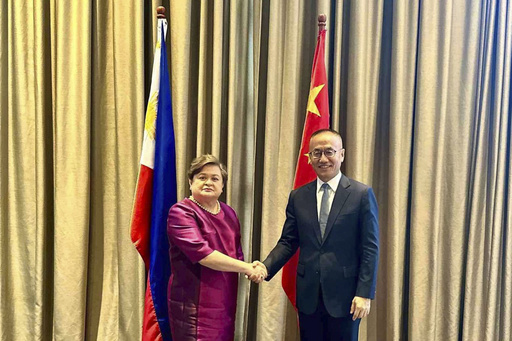MANILA, Philippines (AP) — China and the Philippines held a crucial meeting Tuesday to try to ease mounting tensions following their worst confrontation in the disputed South China Sea that sparked fears of a wider conflict that could involve the United States.
There was no mention of any major agreement, however, after the daylong meeting in Manila that could prevent a repeat of the June 17 clash at Second Thomas Shoal which caused injuries to Filipino navy personnel and damaged two military boats.
The shoal off the northwestern Philippines has emerged as the most dangerous flashpoint in the disputed waters, which China claims virtually in its entirety. Chinese coast guard, navy and suspected militia ships have surrounded the Philippine marines aboard a grounded ship to prevent delivery of food and other supplies to Manila’s territorial outpost.
The Chinese and Philippine delegations “affirmed their commitment to de-escalate tensions without prejudice to their respective positions,” the Department of Foreign Affairs in Manila said in a statement Tuesday night. “There was substantial progress on developing measures to manage the situation at sea, but significant differences remain.”
Philippine Foreign Undersecretary Theresa Lazaro told her Chinese counterpart, Vice Foreign Minister Chen Xiaodong, “that the Philippines will be relentless in protecting its interests and upholding its sovereignty, sovereign rights, and jurisdiction” in the South China Sea, according to the Philippine side.
The Chinese government did not immediately issue any statement about the talks.
An agreement was signed to improve communications during emergencies at sea and both sides agreed to continue talks on enhancing ties between their coast guards but no details were provided. Another confidence-building plan was the convening of an academic forum among scientists and academics to improve marine scientific cooperation.
Ahead of the meeting, the Philippines planned to formally ask China’s delegation to return at least seven rifles that Chinese coast guard personnel seized during the June 17 faceoff at the shoal and pay for damage, a Philippine official told The Associated Press on condition of anonymity for lack of authority to discuss the sensitive matter publicly.
The Asian neighbors first agreed to hold what they call the Bicameral Consultation Mechanism meetings in 2017 to peacefully manage their conflicts. But despite the on-and-off talks, the confrontations have persisted especially under President Ferdinand Marcos Jr., who, unlike his predecessor, has nurtured closer defense ties with the United States as a counterweight to China.
Apart from China and the Philippines, Vietnam, Malaysia, Taiwan and Brunei also lay overlapping claims to the strategic sea, which has rich fishing areas and potentially more undersea deposits of gas than what has been found so far mostly in the fringes of the seaway by coastal states.
Sporadic confrontations have also flared between Chinese forces and those of Vietnam, Malaysia and Indonesia in the past but the Southeast Asian nations have resisted from aggressively confronting China for fear of undermining their economic ties with Beijing.
Under Marcos, who took office in 2022, the Philippines launched a campaign to expose aggressive Chinese actions by making public videos and photographs and allowing journalists to join coast guard patrol ships, which have figured in dangerous faceoffs with Beijing’s forces.
The U.S. has no claims to the contested waters, but it has deployed warships and fighter jets for patrols that it says aim to ensure freedom of navigation and overflight and to reassure allies like the Philippines and Japan, which similarly has territorial disputes with China over islands in the East China Sea.
After last month’s confrontation in Second Thomas Shoal, where Chinese forces were caught on video brandishing machetes, an axe and improvised spears, Washington renewed a warning that it’s obligated to help defend the Philippines under the 1951 Mutual Defense Treaty if Filipino forces, including the coast guard, come under an armed attack, including in the South China Sea.
Marcos said the Chinese actions would not activate the treaty because no shots were fired but stressed that the Philippines would continue to defend its territorial interests at all costs.
—
Rephrased content:
China and the Philippines engaged in a significant meeting in Manila to de-escalate tensions after a recent clash in the South China Sea. The meeting did not result in a major agreement, but both sides reiterated their commitment to reducing tensions. The June 17 clash at Second Thomas Shoal led to injuries and damage to military boats. This shoal has become a dangerous flashpoint, as China claims the area in its entirety.
The Department of Foreign Affairs in Manila stated that both delegations agreed to manage the situation at sea and work on enhancing ties between their coast guards, though differences remain. The Philippine side emphasized its determination to protect its interests and sovereignty in the South China Sea. An agreement to improve communications during emergencies at sea was signed, and plans for an academic forum for marine cooperation were discussed.
The Philippines aimed to ask China to return seized rifles and pay for damages from the June clash. President Ferdinand Marcos Jr. has pursued closer defense ties with the United States to balance China’s influence. Various countries, including Vietnam, Malaysia, Taiwan, and Brunei, also have overlapping claims in the South China Sea, known for its resources and strategic importance.
The United States, not a claimant in the disputes, has conducted patrols in the region to ensure freedom of navigation. After the recent incident at Second Thomas Shoal, the U.S. reiterated its commitment to defend the Philippines under the Mutual Defense Treaty. Despite tensions, Southeast Asian nations have been cautious in challenging China to avoid jeopardizing economic ties.
Under President Marcos, the Philippines has exposed Chinese actions through public disclosures and patrols. While the Mutual Defense Treaty was not triggered by the recent clash, the Philippines remains steadfast in defending its territorial interests. The situation in the South China Sea continues to be closely monitored by all involved parties.
